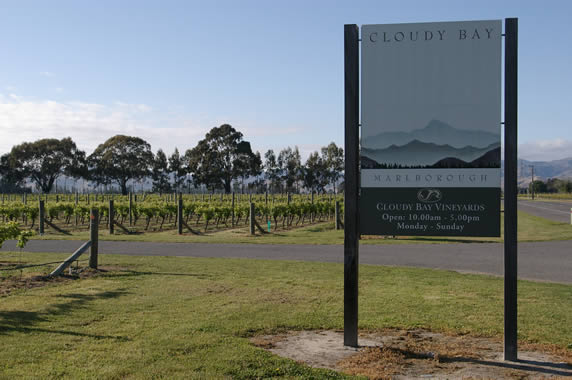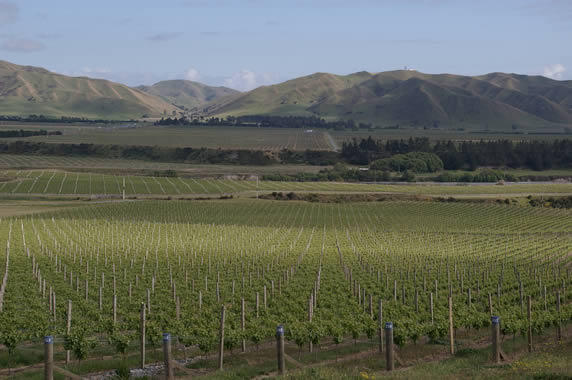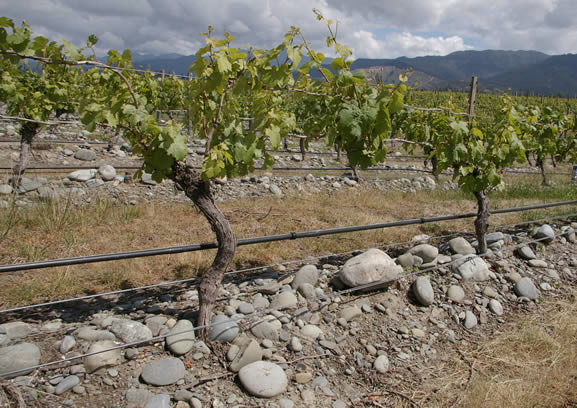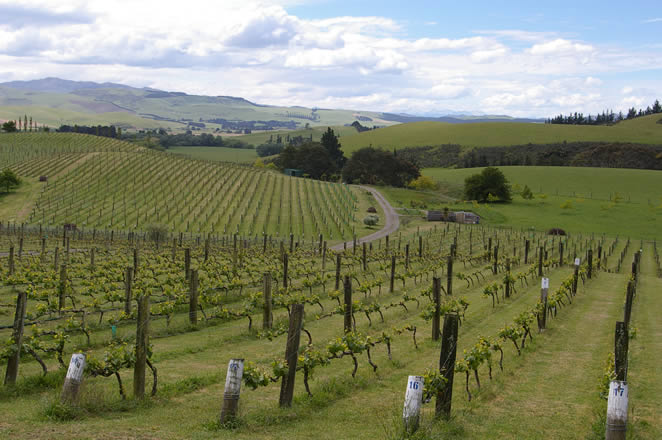|
Visiting
New Zealand's
wine regions
Part 1: introduction to New Zealand

If
you really want to understand a wine, there's nothing quite like
visiting the vineyards it comes from. This isn't terribly logical,
I know. You should be able to glean all the information you need
by way of contextual background from reference books and magazine
articles and from looking at photographs. But invariably, I find
that when I actually visit a winegrowing region, I understand the
wines better.
So
on this trip I was excited to be seeing some of the key New
Zealand wine growing regions for the first time. After spending a
few days at a conference down in Dunedin, which is close to the
end of the earth, I flew up to Blenheim, getting my first view of
Marlborough, New Zealand's pre-eminent wine region as we landed on
the small airstrip literally in the middle of the vines. After
reading so much about Marlborough, and after drinking so many
Marlborough wines, here I was. This is where they come from. This
is the source of those remarkable, lively, piercing Sauvignons
that have so emphatically changed the face of white wine the world
over in the last couple of decades.
I'd
taken a rather different approach with my itinerary on this trip.
It would have been easy to hit the wine regions, one-by-one,
seeing as many people as possible. I had other ideas, though. I
reckoned I could taste most of the wines in London: New Zealand is
strongly export-focused, and there are regular press and trade
tastings showing loads of different Kiwi wines. So my priority was
to spend more time with fewer producers, and to try to dig a bit
deeper.

Marlborough
Timing
was tight, though. I allotted two days to Marlborough, which
wasn't long, with just two visits. Then I was off to Napier, where
my plan was to hire a car and drive up to Gisborne. It's not that
Gisborne is all that an important a wine region; it's just that I
wanted to visit James Millton, one of the leading proponents of
biodynamics in the new world, and I reckoned that this segment –
even though it called for two 3.5 hour drives along winding roads
– was worth the excursion. Then I was to return to Napier to
spend some time at Craggy Range, as well as meeting up with some
of the top Hawkes Bay producers. After this, I planned to spend a
day in the Waipara region, close to Cantebury, which was my point
of departure from New Zealand. Obvious omissions from this trip
were Central Otago and Martinborough, which will have to wait for
next time.

Marlborough
So
some background about wine in New Zealand. In my oldest copy of The World Atlas of Wine, dated 1971, there are no maps of New
Zealand. It’s not even in the index. How can it be that a wine
industry with such global visibility and importance has come from
virtually nowhere to its current position in a short space of
time? And much of this
growth is quite recent. In 1995 there were 204 wineries; in 2006
there were 530. In 1995 there were 6110 hectares of vines; in 2006
there were 22 616. And perhaps most significantly, in 1995 7.8
million litres of wine were exported, while in 2006 57.8 million
litres left New Zealand, netting a healthy half a billion dollars
in revenue (FOB).

Waipara
These
days New Zealand’s most famous region is Marlborough, and
Marlborough Sauvignon Blanc is its most famous and instantly
recognizable export. The first vines were planted in this
remarkable region in 1973. Marlborough excels with Sauvignon
Blanc, but also produces attractive Pinot Noir and Pinot Gris.
Chardonnay and Riesling also do well here. The next most
celebrated NZ region is Hawkes Bay, which is able to make a wide
range of wine styles, including some fabulous Syrah and
respectable Bordeaux blends. Chardonnay can be very good here.
Perhaps next highest in profile is the relatively new (even by NZ
standards) Central Otago region, famous for Pinot Noir. Another
Pinot Noir-dominated region is Wairarapa, which includes the
Martinborough district. Don’t confuse Wairarapa, at the base of
North Island, with emerging Waipara, west of Christchurch on South
Island, which could yet prove to be the source of New Zealand’s
best Pinot Noir. Other significant regions are Gisborne, Nelson
and Auckland.
With
consistently high quality, and prices to match, New Zealand is the
envy of the wine world. There’s something about the precision of
flavours that New Zealand manages to capture in its wines that
resonates with modern wine drinkers. Trump cards appear to be (1)
arguably the new world’s best Pinot Noir; (2) remarkably
piercing, aromatic Sauvignons (although it may be that other
countries can emulate this style successfully, for less money);
and (3) increasingly convincing aromatics such as Pinot Gris and
Gewürztraminer.
Over
the next few weeks I’ll be bringing you in depth, anoraky
reports from my trip.
Back
to top
|

